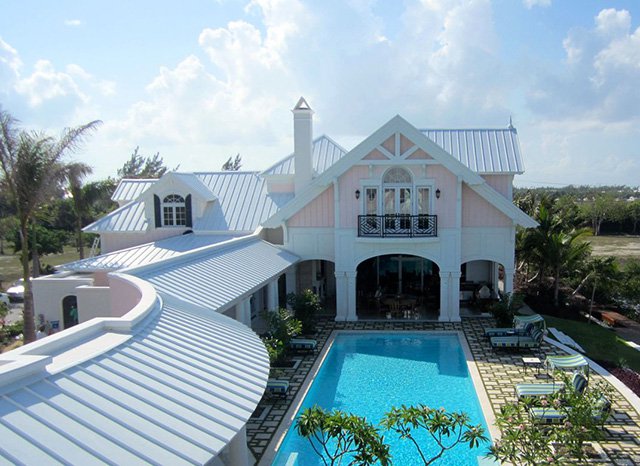
By the Shore: MRA Offers Expertise to Help U.S. and Canadian Homeowners Better Protect Their Homes in Harsh Coastal Environments
From Florida to the California coast, Vancouver B.C. to the Gulf states, homeowners who live near the ocean understand the battle all too well. Salty air is hard on homes, causing expensive, premature aging of building materials that can lead to repair expenses and premature replacement.
That’s especially true for roofs. Quality metal roofing is known for its exceptional performance and is a smart choice for marine environments, but attention to detail is a must. According to the Metal Roofing Alliance (MRA), these five key factors when using metal roofs for marine and coastal applications are essential for long-lasting protection and performance:
-
It’s all about location, location, location
Not all marine environments are created equal. Drier coastal environments with light rainfall and heavy breaking ocean surf that cause spray and salty air (such as in Southern California) are harder on roofs and exterior building materials. Areas that receive greater rainfall help regularly rinse off salt, assisting in protecting roofs.
Proximity also matters: The closer to the shoreline, the more building materials bear the brunt and corrosive effects of salty air. Paint and material suppliers typically define marine environments by distance from salt water, ranging from 1,000 feet to one mile. But not all suppliers use the same definitions, nor do they all require the same paint system. Review warranties carefully for specific product specifications, durations and maintenance requirements.
-
Choose alloys with coastal advantages
Aluminum, anodized aluminum, stainless steel, zinc and copper are preferred for coastal environments due to their corrosion resistance. Architectural zinc products offer “self-healing,” low-maintenance, corrosion-resistant performance but can be cost prohibitive. Zinc coatings, i.e., galvanized or Galvalume coated steel, are well-developed methods of protecting steel from corrosion, and typically offer more affordable protection. High performance coatings, pretreatments, primers and finish coats that serve as a barrier also can help augment and maximize protection in coastal environments, but it’s important to pay close attention to manufacturers’ performance guidelines and recommendations.
The big no-no is using sub-quality or the wrong mix of metals for any part of the roofing system, especially in a marine environment. Even if they are not visible, non-resistant and the wrong type of accessories, clips and fasteners in the roof or wall can speed up the corrosion process and can lead to failure. Stainless components should never be in direct contact with aluminum, Galvalume, or galvanized metal panels and dissimilar metals can cause galvanic corrosion and greatly impact performance. Panel manufacturers can provide guidance on the best choices for accessory materials to ensure all components of a metal roofing system are suitable for marine environments.
-
Pay attention to installation details
All areas of a metal roof should have natural drainage and avoid causing salt water to dam. Any flashing design that may trap or hold moisture or salt and prevent fresh water rinsing also should be avoided. Roof slope also matters. A low slope roof can allow salty water to sit for longer rather than drain rapidly, making it subject to more severe corrosion conditions.
In coastal environments, even how materials are stored prior to installation and attached to the roof decking can greatly impact longevity and performance. Minimizing exposure, including any unprotected edge is critical. Concealed fasteners are recommended to help minimize exposure to corrosive environments. Some experts advise a “hemmed” installation, meaning exposed metal edges are folded and tucked underneath so they are not exposed to environmental elements. Bottom line: the fewer discontinuities, cuts and penetrations, the better.
-
Plan for long term care
Metal roofs are notoriously easy to clean and maintain. A simple squirt of water and using gentle soap is often all it takes to maintain a beautiful metal roof and help ensure its long life. Homeowners in coastal conditions may want to rinse off their roofs more frequently, especially if they live in areas with little rainfall and saltier air. Consider washing or rinsing roof areas where overhangs prevent rainfall from rinsing salt spray deposits off to protect its long-term reliability. Once again, your manufacturer’s recommendations are your best guide to properly maintain and care for your metal roof.
-
Salty air is just the start
Homeowners in coastal areas need to consider all potential conditions, not just salty air. Hurricane force winds often go hand in hand with shoreline living. Hail is sometimes a challenge and intense sun, high humidity, and heat are common in coastal climates ranging from Florida and Texas, to California and Hawaii. Roof systems need to be designed to handle and perform under all of these intense and extreme climate conditions, making strong, quality metal roofs with high performance coatings and experienced installation practices a must.
For more information and a comprehensive Buyer’s Guide available as a free download, visit www.metalroofing.com